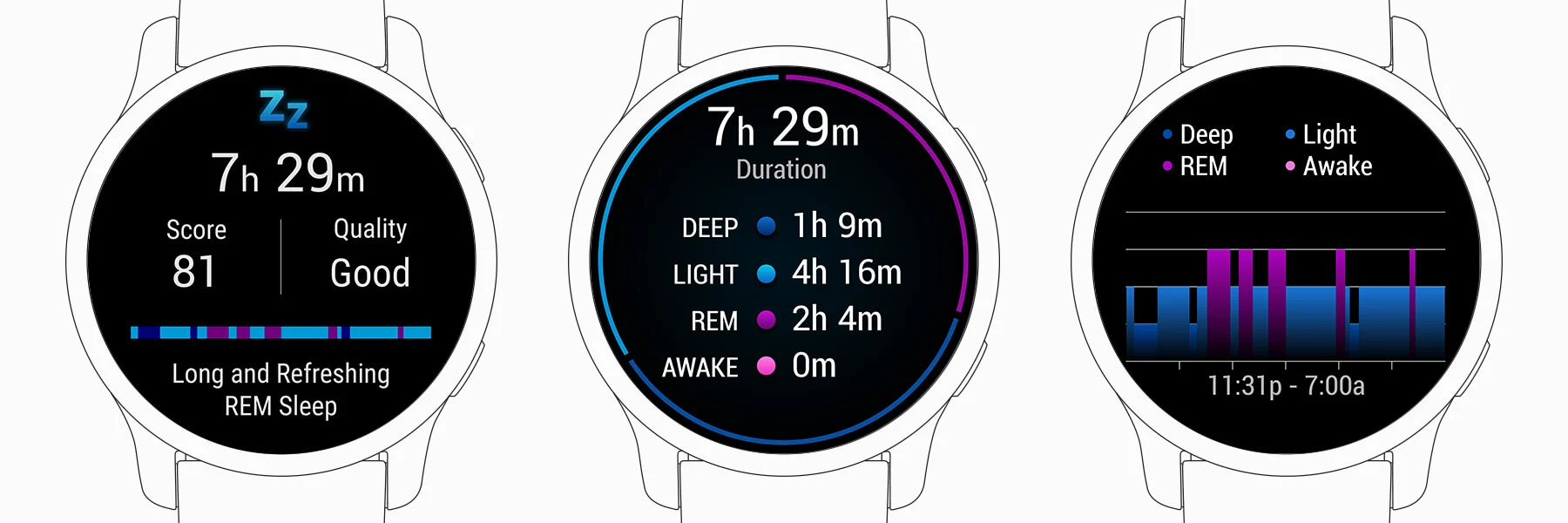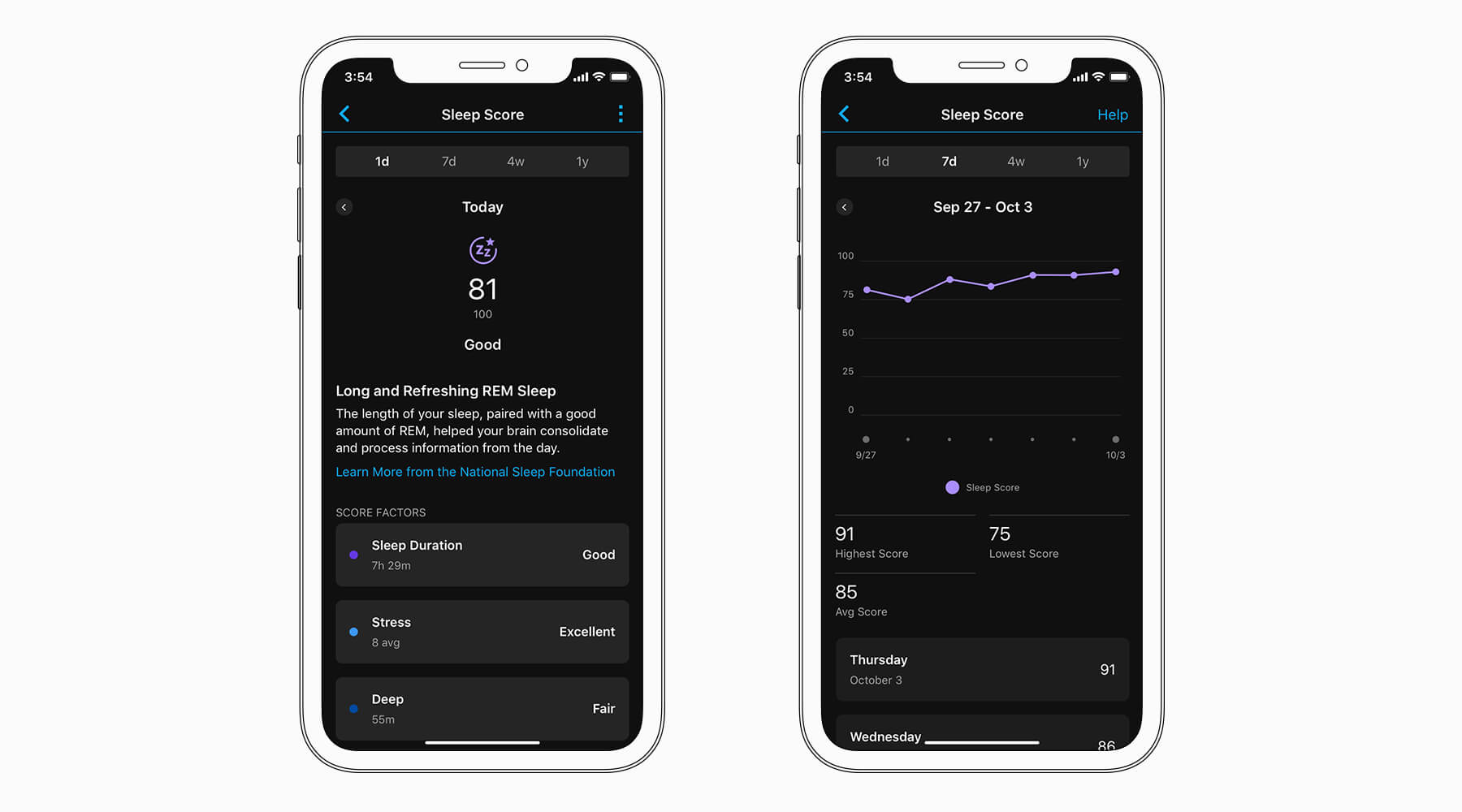
Advanced sleep tracking in compatible Garmin devices takes into account multiple factors to help you understand your sleep1. In addition to the basics, such as when you fell asleep and when you woke up, you can see times when you were awake and how much time you spent in key sleep stages (light, deep, REM). You will also see when those stages occurred during the night.
Sleep times and sleep stages are identified using a combination of heart rate, heart rate variability and body movement data. Age information that you enter during setup and detected personal physiological baselines provide valuable context for the analysis and improve the reliability of your sleep tracking.
Compatible Garmin devices also track your respiration rate and blood oxygen saturation (Pulse Ox) levels during the night. Adding this information to your sleep chart offers a more comprehensive view of your sleep.
Sleep is crucial to your physical and mental well-being. Regularly getting enough quality sleep promotes good health, can improve your mood, helps maximize the benefits of exercise and provides many additional benefits.
Check your sleep data, and look for changes and trends over time. This will help you gain insight into the often-complex relationship between what you do when you are awake to how well you sleep at night.
A bad night’s sleep is easy to explain away in the moment, but recognising longer-term trends can be a powerful motivator for lasting change. And when things are going well, you benefit from the confidence that comes from evidence you are on the right track.
Select Garmin devices with advanced sleep tracking also include a sleep score. Nightly scores (0–100) may be paired with personalized insights derived from your own activity and lifestyle data. These tips appear when an opportunity is identified to help you understand how factors such as daily stress levels, activity patterns and bedtimes influenced your sleep.
Your nightly sleep score is calculated based on a combination of sleep duration and sleep quality factors. How long you slept is compared to globally accepted age-based recommendations2. Quality aspects of your sleep score come from a combination of sleep architecture, stress data, interruptions during the night and other factors3.
Sleep architecture refers to how much time you spent in light, deep and REM sleep stages and the patterns formed by transitions between these stages during the night. The stress element is an analysis of heart rate variability interpreted to reveal the balance of sympathetic vs. parasympathetic activity occurring within your autonomic nervous system. When your heart rate is low and your heart rate variability is high compared to normal, it is a strong indication of parasympathetic dominance, meaning your body is stressed and actively replenishing resources depleted during the day.
Other contributors to your sleep score include restlessness, the number of times you are awake for longer than 5 minutes, and the total amount of time you spent awake.
In a sleep laboratory, sleep stages are identified with specific brain wave and neuronal activity patterns. These patterns are typically reflected physiologically as changes in heart rate, heart rate variability and respiratory patterns. Identifying these physiological changes while you are asleep provides valuable clues for recognizing sleep stages in real-world conditions outside the confines of a sleep laboratory.
Studies indicate that each sleep stage plays a role in your mental and physical recovery processes.
Light sleep is the first stage of sleep. Eye movements and muscle activity slow during light sleep as your body gets ready for deep sleep.
As you transition to deep sleep, eye and muscle movements stop completely. Your heart rate and breathing slow. At this point, you become difficult to rouse and are disoriented if awakened. It’s generally agreed that deep sleep has a myriad of health benefits. For example, it helps aid muscle recovery.
REM sleep is considered the final stage of a sleep cycle. Dreams are common during REM sleep. REM sleep stages tend to start short and grow longer throughout the night. The REM sleep stage is believed to be when your brain has a chance to process and make sense of data. It may even be linked to how you learn new skills.
In general, it’s best for sleep to be continuous through the night, with few to no stretches of awake time.
Older Garmin devices and those without integrated wrist-heart rate monitoring capabilities use movement-based sleep tracking to analyse wrist or body movement captured with an accelerometer. This algorithm also considers the time of day and provides more basic insight into sleep. It can estimate whether you are awake, in a light level of sleep or a deeper level of sleep. However, detection of specific sleep stages is not possible in these devices.
